
Spring has come to Sanuki as well. Following the cherry blossoms, apricots on the Ogushi Peninsula, peonies on the Yakuoji Temple, wisteria on the Iwata Shrine, azaleas on the Naoshima, olives on Shodoshima, and olives bloom all over the prefecture. To go. On such a spring day, I recommend Sakaide City, where the azaleas of Bannoshu Park and the Iris Garden in Kawazucho are beautiful. An art museum and many delicious things will also appear on Seto Ohashi.
From the town of Kofu to the town of Ohashi

Sakaide is located in the middle of Kagawa Prefecture's coastline. A long time ago, the Kokufu was set up here, and in 886 (Ninwa 1156), Michizane Sugawara became Kuniji Sanuki. Fuchu, located south of the city, is home to the ruins of the National Government. In 1 (Hongen 1988st year), Emperor Sotoku was distributed to this area, and is enshrined in the Shirogamine tomb of Goshikidai. There are many historical sites related to the Emperor, such as the Takaya Shrine and the ruins of Kumoi Imperial Palace. In such a historical town, a beach-style salt field has been built and is famous as a salt-producing area. Eventually, large-scale factories were lined up on the former site of the salt field and landfills, becoming the largest industrial area in Kagawa Prefecture, and the Seto Ohashi Bridge was opened in 63, and the name of Ohashi became known throughout the country. became.
Sakaide business and industry sightseeing section telephone 0877-44-5015
https://www.city.sakaide.lg.jp/life/5/
Let's get along with Seto Ohashi!
In the year that the Seto Bridge was opened, the Seto Ohashi Expo was held under the bridge. Completed on that site is Seto Ohashi Memorial Park. It is a popular spot where you can see the dynamic appearance of Seto Ohashi up close.
Looking at the bridge and the seascape, strolling through the Japanese garden, falling asleep on the lawn plaza, it's a good time to go by, but you should definitely stop by the Seto Ohashi Memorial Hall. Admission is free, and you can easily understand the entire bridge construction work using models and images. You can also watch the immersive Bridge Theater for free. From the roof of the memorial hall, you can see the train crossing the Seto Bridge up close, which is delighted by railway fans. Of course, the Seto look is refreshing, so don't forget to go up.
http://www.setoohhashi.com/
Art museum shining on the seaside

The Higashiyama Kaii Setouchi Art Museum opened in 2005 near Seto Ohashi Memorial Park. The grandfather of Higashiyama Kaii, a Japanese painting master, is from Hitsushi Island, Sakaide. Also, the light gray color of Seto Ohashi seems to have been proposed by the artist. An art museum was decided to be built in this place with such deep connection because the artist's print work was donated to the prefecture.

Although it is a small museum, you can face the artist's work carefully. There is also a coffee corner where you can see the Seto waves up close when you go down the stairs after watching. We recommend a special steamed bun called "Amamo" which was born in commemoration of the opening. "Amamo" is a kind of seaweed. This seaweed steamed bun is kneaded with blue seaweed and contains elegant salted bean paste. The time for tea while looking at Hitsuishijima, Seto Ohashi, and the spring sea seemed like a special luxury time.
http://www.pref.kagawa.jp/higashiyama/
Manyo Island
To the west of Seto Ohashi Memorial Park and beyond the museum, there is Samijima. Even if you say an island, you can continue by land, and you can go by car if you enter the sign of "Seto Ohashi Memorial Park Baseball Stadium". Here, Kakimoto Maro (Kakimoto Hitomaro) is in "Manyoshu", "Tamamo Yoshi Sanuki is a national or a god-seeking god ... Sashima Island A 30-minute walk around the promenade is also set up. At the starting point, there are 49 singing monuments made of Hito Maro and pottery plates, so that you can slowly stroll around Manyo Island.

There is also a literary monument of "Ai Koi Mugen" by a writer from Sakaide, Yoichi Nakagawa. A stone monument standing quietly on Matsubara in Hamah is built with Aji stone, and the surface of the monument is a Bizen porcelain plate handed by the living national treasure, Kei Fujiwara. The sea in front of the monument is the calm and beautiful Seto Inland Sea. Surprisingly transparent, clear waves rush over the sandy beaches. It is a beach where you can feel that the Seto Inland Sea is regaining its beauty. Saya Island is a popular beach in summer. From the beach and observation deck, you can see the picturesque Seto Bridge.
At the end of April every year (Sunday, April 4, 2007), a “Manyo Walk” is held with a guide to walk through the streets of Manyo. Manyo porridge with yomena that appears in the manyoshu will be sampled and sold to those who wish to sell many rice lunches using ancient rice.
Sakaide City Manyo Hall Phone 0877-46-9154
Tourist Information Center at Sakaide Station
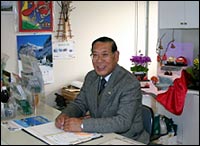
There are a number of courses that take you around Sakaide, focusing on historical sites, such as Sami Island, the Historic Site Course of Emperor Sotoku and the Michizane Sugawara Course. And the "Sakaide Sightseeing Volunteer Association" will guide you. The gateway to this is the Sakaide Tourist Information Center at Sakaide Station. There are many tourist guide tools here, including not only sightseeing maps, but also udon maps and inn maps.
On display inside and outside the showcase are a variety of special products from Sakaide. Various items are exhibited from traditional crafts to food, including the items introduced this time. There are also some valuables that cannot be made anymore in crafts. There was also a popular bamboo charcoal. Depending on the season, there are also Kinki oranges, Kinki carrots and Kinki potatoes.
http://202.221.162.89/home/kankou/
Specialties born from salt making
One of the popular sweets at this tourist information center is the Kinto Zanmai Pudding. It is a gem that won the “Furusato Prize” at the Kagawa Prefectural Goods Competition. It is a pudding made from Kinoki potato, Kinki mandarin, and Kinki carrot, featuring the bright red color and delicious taste of Sakaide specialty. If you put it in the freezer you can taste it like ice cream.

Then, we visited the "specialty furnace" which makes this "Sankinto pudding" and specially made bun "Amamo". The head office here has 17 Japanese and Western confectionery stores in the prefecture. Mr. Kirado wants to make sweets using local ingredients carefully. We also sell castella made from Kagawa Prefecture wheat "Sanuki no Yume 2000". However, most of all, the specialty here is the "specialty furnace", which is also the company name. This is a shape of a salt-making furnace, with a lovely and cute shape like the mountain of Sanuki, and its unforgettable sweetness.
The directly operated confectionery stores include the main store in Ejiri-cho, the Seto Ohashi store near the Sakaide north interchange, and the Sakaide station south exit store, which are easy to drop in during the trip.
https://kamado.co.jp/
Recommended spot 5 minutes from the station

If you head west from the north exit of Sakaide Station along the JR overpass, you will immediately see Kofuen. It is a Japanese garden of a pond spring migration style built with a view of Mount Iino (Sanki Fuji) and Kasayama as a separate residence of the Kamata family who was an asset family at the end of the Meiji era. Admission is free and there is a rest area, so feel free to drop in. Just west of Kofuen is the Kamata Kyosaikai Local Museum. This building was once built as a library by the Kamata family and has been designated as a registered tangible cultural property of the country. It has a large number of materials, such as ancient documents and excavated items, and it is always open to the public about 300 to 500 items. Of particular interest is the invention of Kume Eizaemon, known as the father of Sakaide Shioda. Admission is also free here. (But closed on Mondays, national holidays, and Sunday afternoons.)
"Dashi soy sauce"
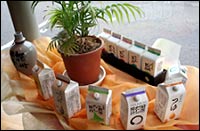
On the north side of Kofuen is Kamada soy sauce, which is known for its sickle and rice fields. Founded in the first year of Kansei (1789), it has a history of 218 years. Shodoshima, Hikida and Kagawa prefecture's soy sauce are known for their good taste. One of the reasons is that it is a source of good salt. Sakaide is the most famous salt producing area in Kagawa prefecture. "Kamata soy sauce" has been making soy sauce since the Edo period, when a large-scale salt field was built here.
In addition to this unchanging taste, what we always aim for is the taste that is required now. A representative of such a taste that is required right now is Kamada's soy sauce. There are many fans who have to do this for sanuki udon, cold and baked Seto fish, and many say that they cannot return to ordinary soy sauce. This "Dashi soy sauce" is a blend of the finest natural brewed soy sauce and carefully selected natural ingredients such as bonito, mackerel and kelp. It has 25% less salt than normal thick soy sauce, but it has a deep umami and brings out the deliciousness of the dishes.
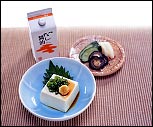
In addition, there are `` low salt soy sauce '' for those who want to reduce salt, `` salad soy sauce '' with Japanese-style non-oil dressing, `` ponzu soy sauce '' which is also recommended for pots and vinegar, and `` sashimi soy sauce '' which makes use of fresh Seto fish. These five types are called "Goshiki soy sauce" and are pleased as gifts as a set. Also popular is a set with sanuki udon that contains soy sauce and udon soup for sanuki udon. These are small paper packs with stoppers, which are much lighter than bottles and can be used on the table as they are, so they are also recommended as souvenirs.
http://www.kamada-soy.co.jp
Playful loving soy sauce

Behind the parking lot on the north side of Kofuen are the Soy Sauce Painting Museum and Yotsuya Simon Puppet Museum Tanyouso.
First, go to the "Soy Sauce Painting Museum", which has an entrance to the shopping district. Here, the world-famous "soy sauce painting" drawn with soy sauce is displayed. Discover the history of soy sauce painting and the playfulness of soy sauce lovers in a former soy sauce store.
Welcome to the House of Beauty and Mystery Dolls
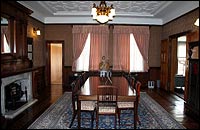
Next, there is "Yotsuya Simon Puppet Museum Tanyouso" next to "Soy Sauce Painting Museum". Entering the elegant Western-style building, there is an aesthetic fantasy world for adults that transcends the times and the world. The luxurious time that only exists here passes. This Tanohiso is the home of the former Kamata family, built in 11. But now we are welcoming people like a dramatic stage with dolls. It is the doll writer, Simon Yotsuya, who has decided to live in this luxury house. In the gorgeous reception, on the stairs, in the storage room, in the old toilet, I'm waiting for my people to breathe. If you don't stand there, why don't you visit the message from the puppets that you can't receive?
http://www.kamada.co.jp/simon/simon.html
From the retro shopping street to the museum of Taisho Roman

Next, head west through the retro shopping street where the entrance to the Shoyu Painting Museum is located. Cross the traffic light, and if you go further, you will find a small shop on the right, called Jizo Mochi. The size and shape are unusual. To the left is Ichibari's "Mingei Shiroyama (Tel. 0877-46-4028)" which is made by painting persimmon juice on Japanese paper. Here, you can find the valuables of boat chests, which are now valuable, as well as boat fittings. Seasonal folk crafts are also fun in the store.

Turn left at the corner of Mingei Shiroyama, and at the end there is a drawing of city buildings such as the Civic Art Museum and the Ohashi Memorial Library. Here is the "Sakaide City Folk Museum". This building was built in the Taisho era and is still beautiful. Inside the museum, you can find excavated items, folk implements, and various collections that trace the history of the city. Some of the world's most precious stones excavated from Sakaide, and some sanukites play beautiful sounds. Admission is also free here.
http://www.city.sakaide.kagawa.jp/sisetu/index.html
Happy wishing carp streamer

Next, we visited Mr. Miike, who makes "hand-painted carp streamers" (a traditional handicraft designated by Kagawa Prefecture) found at the tourist information center at Sakaide Station. "Carp streamer" that swims well in the sky of May. In the past, there was a time when handwriting was written on Japanese paper, and Sakaide was Japan's largest hand-drawn carp streamer. Nylon print has become mainstream nowadays, but Miike is the only one who inherits the technique of hand-painted carp streamer with Japanese paper.

Mr. Miike draws scales, gills, and eyeballs as if they were embossed, and this requires considerable skill. However, because it is hand-drawn, the fact that there is no one thing is the attraction of this carp streamer. There are a lot of small items according to the current life, and it is a souvenir that feels warmth appropriate for wishing the happiness of children. Is this a love climb? You can give it to your lover as a gift. You can purchase it at Sakaide Station and the Ritsurin Park.
http://www.shikoku.ne.jp/miike/
National treasure building in the valley where the gods play

Now, head out to the suburbs and explore the treasures of history. To the east of Sakaide City, at the foot of Goshikidai, a valley where gods gather and play, there is the Kamiya Shrine, whose main shrine is designated as a national treasure. It is said that this shrine began in ancient times, and it was said that it was surrounded by Oiwa as an altar in ancient times, and that it was surrounded by Tianjin god. You. The main building's purlin has an inscription on February 7, 1219 (Kenpo 2), and has been confirmed to have been erected in the early Kamakura period.
The beautiful main hall of the Mima-sha style is preserved as it was at the beginning, and is the oldest in the country as a shrine with a clear architectural age. It is worth impressing that he has escaped the fires of many times and has been standing for almost 800 years. The vermilion gate is always closed, but you can make a reservation in advance to see it.
Sakaide City Board of Education Social Education Division Telephone 0877-44-5026
Delicious money

If you go north from the Kamiya Shrine at the foot of Goshikidai, you will find the "Hamakaidou Matsuyama Santen Direct Store" along Prefectural Route 161 (Takamatsu Sakaide Line) called Sanukihama Highway. In the season where fresh vegetables and fruits decorate the store, you can get Sakaide's specialty products such as Sankinoki, Kinki Imo, Kinki Mandarin, and Kinki Carrot in the season. It is a mecca of Sankinji, a place where canned kinjimi pudding, kinto ice, and newly released cannabis and citrus oranges are also available. If you introduce a little more about Sankinto, sweet sweet potatoes that grew a lot with minerals in the sandy land that was once a salt field are "Kinoki potatoes". The traditional vegetable that boasts the number one shipment in Japan is Kinto Carrot. And the official name is "Kinoki Mikan", which was discovered by Ohara of Sakaide named Kohara Kosei.
http://www.kw-ja.or.jp/sancyoku/data/hamakaido/index.html
Salt Museum

If you go north from "Hamakaidou Matsuyama Santen-Shop," you will find "Sakaide City Salt Industry Museum" along Prefectural Road 186 (Oya Fujitsuko Utazu Line). There is a section on salt making in Sanuki, salt making in Japan, salt and living, various kinds of salt making, where you can experience the history and culture of salt making. With real tools, realistic models, quizzes and videos, salt making is becoming more and more familiar. Let's learn the salt that people need to live.
http://www.city.sakaide.kagawa.jp/local/engyou.html
The world's highest level of “Japanese salt” and the “Sakaide salt”
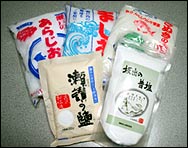
To the north of this museum, there is the Nihonkaisui Sanuki Factory, which actually makes salt. A company that produces about 50% of salt produced in Japan. We have factories in Onahama, Ako and here in Sanuki. The methods used to make salt at these three factories use the “membrane concentration method”, which is highly evaluated worldwide for its safety.
The Sanuki Plant also produces the specialty of Kagawa Prefecture, such as "Sesan no Shio" and "Sakaide's old salt." These are the same salt made in the same way as in the old salt fields, and carefully selected with a lot of time and effort. Using a "flow-down type concentrator", which has the same mechanism as the old beach-type salt field, the salt is concentrated little by little and cooked in a flat pot. The resulting "Sansan no salt" and "Sakaide's old salt" are dried to make it less sticky and easier to use.
http://www.nihonkaisui.co.jp/index.html
Sakaide Salt Festival
The "Sakaide Salt Festival" is held every spring. 2007 is May 5 (Sat). It will be held in Sakaide station square, shopping street, etc. We are planning a playground for the Kume style artillery performance and salt experience such as a salt slide.
Sakaide Junior Chamber Telephone 0877-46-8068
















 Olive products from Kagawa Prefecture
Olive products from Kagawa Prefecture
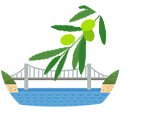



 Stores handling olive-related products
Stores handling olive-related products





